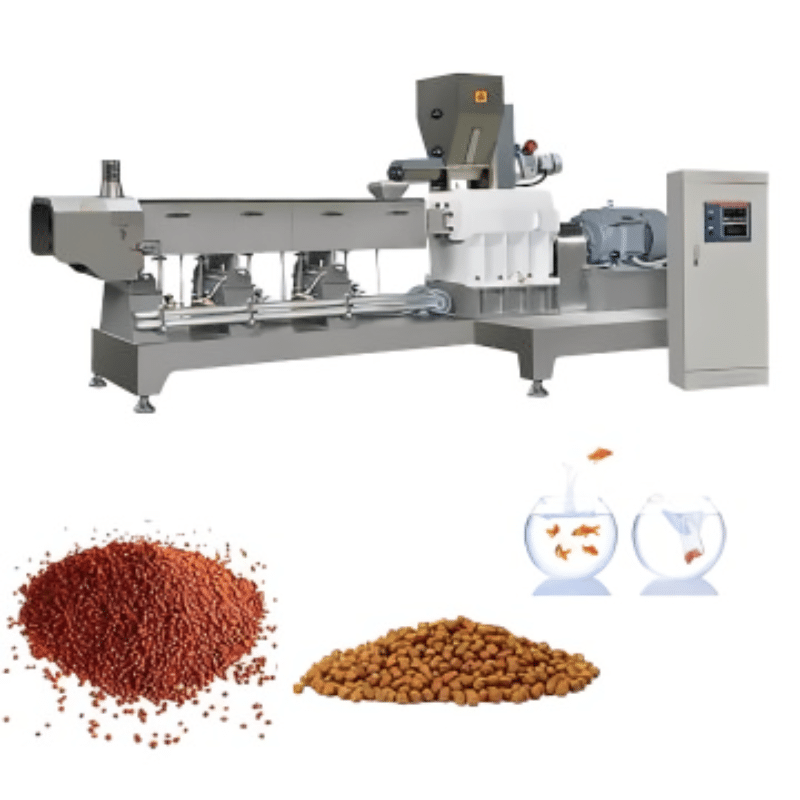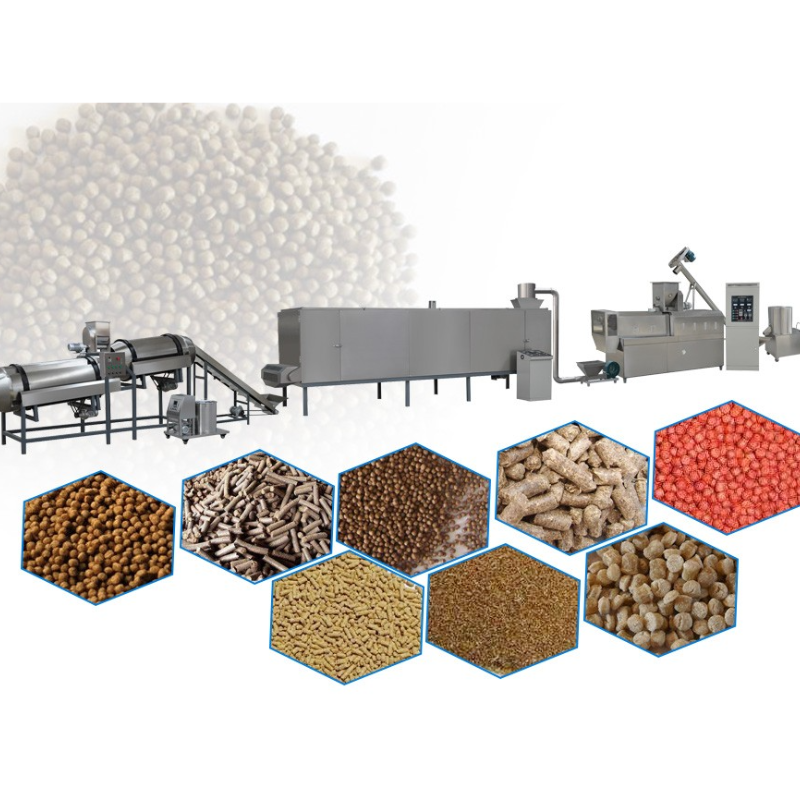Floating Fish Feed Machine
Home » Food Machine » Floating Fish Feed Machine
The Floating Fish Feed Machine is designed for efficient and high-quality fish feed production, providing floating pellets that are easy for fish to consume and digest. Suitable for both small-scale and large-scale aquaculture, this machine ensures optimal pellet size and buoyancy. For those exploring options and looking to balance quality with budget, we offer details on floating fish feed machine prices and specifications to help you find the best fit for your needs.
- Floating Fish Feed Machine Price: $1,000 - $35,000
Get Information on Floating Fish Feed Machine Manufacturers
Find Your Floating Fish Feed Machine
The Floating Fish Feed Machine efficiently produces floating pellets for aquaculture, catering to different scales with both dry type and wet type options. Available in single screw and twin screw models, it can generate pellet sizes from 1mm to 15mm, ensuring compatibility with various fish species’ needs. Key components like the floating fish feed extruder machine, mixer, and pelletizer work together for consistency, making it a versatile choice. This fish feed floating pellet making machine is designed to support reliable, high-quality feed production.

- Compact Design for Easy Operation
- Low Energy Consumption Model
- Simple Maintenance and Cleaning
Price: $1,000 – $2,000

- Enhanced Pellet Density and Texture
- Steam Injection for Nutrient Retention
- Adjustable Pellet Size Options
Price: $2,000 – $3,000

- High-Efficiency Twin Screw System
- Consistent Pellet Shape and Quality
- Fast Processing Speed for High Output
Price: $5,000 – $7,000

- Advanced Heating System for Stability
- Optimized for Large-Batch Production
- Precise Temperature and Moisture Control
Price: $8,000 – $12,000

- Single Screw with High Stability
- Energy-Efficient Extrusion Process
- Ideal for Consistent Pellet Formation
Price: $15,000 – $20,000

- Maximum Capacity with Twin Screw Design
- Enhanced Durability for Industrial Use
- Adjustable Settings for Pellet Customization
Price: $20,000 – $35,000
Floating Fish Feed Machine Technical Parameters
| Capacity (kg/h) | Main Power (kW) | Feeding Power (kW) | Cutting Power (kW) | Screw Diameter (mm) | Conditioner Power (kW) | Application |
|---|---|---|---|---|---|---|
| 100 | 11 | 0.4 | 0.4 | 40 | 0.37 | Ideal for small-scale fish farms, producing floating feed pellets for starter feeds. |
| 300 | 22 | 0.75 | 1.0 | 60 | 1.1 | Suitable for medium-sized aquaculture operations, providing balanced nutrition for juvenile fish. |
| 500 | 37 | 1.1 | 1.5 | 90 | 2.2 | Optimal for commercial fish farms needing consistent pellet production for growing fish. |
| 800 | 55 | 1.5 | 2.2 | 120 | 3.0 | Designed for larger farms with high feed demand, producing pellets for mature fish and other aquatic species. |
| 1200 | 75 | 2.2 | 3.0 | 155 | 4.0 | High-capacity machine for extensive fish farming, covering multiple feeding stages. |
| 2000 | 132 | 2.5 | 4.0 | 195 | 5.5 | Best for industrial-scale aquaculture, supporting large-volume feed production for diverse fish species. |
Floating Fish Feed Manufacturing Equipment
Mixer
The mixer is the initial stage in the fish feed production line, where raw materials are blended to achieve a uniform mixture. This ensures that essential nutrients are evenly distributed in each pellet. By using a high-efficiency mixer, the quality and consistency of the feed are enhanced, supporting optimal fish growth.
Screw Conveyor
The screw conveyor transports the mixed ingredients to the extruder, maintaining a steady flow of materials. Designed for smooth and efficient operation, this conveyor minimizes spillage and wastage. It plays a key role in automated feed production, keeping the process continuous and reducing manual handling.
Extruder
The extruder is the central component of the floating fish feed machine, responsible for shaping and cooking the feed under high temperature and pressure to create floating pellets. Available in both single screw and double screw configurations, each type offers unique advantages. The single screw extruder is ideal for basic, cost-effective operations, providing consistent pellet quality with straightforward operation. In contrast, the double screw extruder is designed for more advanced processing, allowing greater flexibility in pellet size and shape, and better control over feed density. Both options ensure that the pellets produced are highly digestible and suitable for various fish species, enhancing the efficiency and versatility of the fish feed production line.
Air Conveyor
Dryer
The dryer removes moisture from the extruded pellets, ensuring they are durable and have a longer shelf life. This machine uses controlled heat to reduce moisture to an optimal level, preventing spoilage during storage. A well-dried pellet is crucial for maintaining the stability of the floating fish feed in water.
Hoister
The hoister lifts and transfers the dried pellets to the flavoring machine. This equipment enables the efficient movement of feed through the production line, reducing manual labor and maintaining product integrity. Its design allows for smooth handling of large volumes, supporting high-capacity operations in fish feed production.
Flavoring Machine
The flavoring machine coats the pellets with attractants or supplements to enhance the feed’s palatability and nutritional value. This step is especially important for encouraging fish to consume the feed. By adding oils or flavors, the machine improves the overall quality of the fish feed pellets, making them more appealing and beneficial for fish growth.
Frequently Asked Questions
A Floating Fish Feed Machine is designed to produce floating fish feed pellets that are easy for fish to consume and digest. It works by mixing raw materials, extruding them under high temperature and pressure, and shaping them into floating pellets. The process involves various equipment such as mixers, extruders, dryers, and flavoring machines.
Single screw extruders are cost-effective and simpler to operate, suitable for standard feed production. Double screw extruders, on the other hand, offer more control over pellet size, shape, and density, making them ideal for more customized feeds. Both types are commonly used in floating fish feed pellet machines depending on production needs.
The fish feed pellet machine can produce pellets ranging from 1mm to 15mm, suitable for different fish species. Pellet size can be adjusted by changing the mold in the extruder, allowing flexibility to meet various dietary requirements for both small and large fish.
The dryer removes moisture from the pellets, making them durable and long-lasting. By reducing moisture to an optimal level, the dryer helps prevent mold and spoilage, ensuring the pellets remain stable and float well in water.
Regular maintenance of a fish floating feed machine is essential for ensuring consistent performance and longevity. Key maintenance tasks include cleaning the extruder to prevent material buildup, checking and lubricating moving parts to reduce wear, and inspecting electrical components for safety. Routine maintenance helps minimize downtime, ensures pellet quality, and extends the lifespan of the equipment.
The machine can handle a variety of ingredients, including fish meal, soybean meal, corn, wheat, and other nutrient-rich raw materials. These ingredients are mixed and processed in the fish feed making machine to create balanced feed that promotes fish growth and health.
